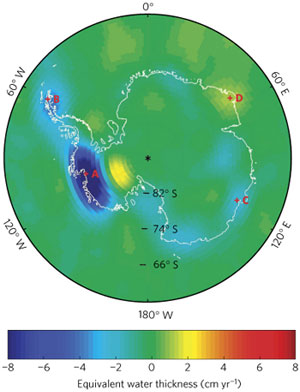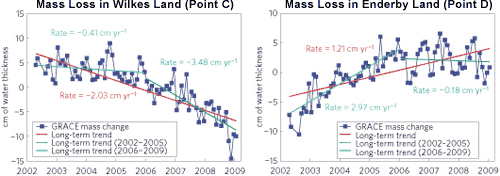East Antarctica is now losing ice
Posted on 24 November 2009 by John Cook
Over time, I gradually update what the science says on each skeptic argument to include new papers (or old papers I hadn't read yet). The idea is that a clearer picture will emerge as new research and data comes out. For example, skeptics used ice gain in the East Antarctic interior to prove that "Antarctica is gaining ice". The original response was that while East Antarctica was gaining ice in the interior, it was losing ice around the edges. These two effects roughly cancelled each other out, leaving East Antartica in mass balance. When you include strong ice loss from West Antarctica, the continent was overall losing ice. Last month, this was updated with the latest satellite data finding that Antarctic ice loss was now accelerating. Today, I've updated the Antarctica page yet again as the latest data shows that East Antarctica is no longer in mass balance, but losing ice mass.
The results are published in Accelerated Antarctic ice loss from satellite gravity measurements (Chen 2009) which compares two independent measurements of Antarctic ice loss. One method is the GRACE satellites which measure changes in gravity around the Antarctic ice sheet. The latest GRACE data analyses measurements from April 2002 to January 2009. Another method to determine mass balance is to combine snowfall estimates with InSAR satellites. These use radar waves to measure the speed of ice sheets as they calve into the ocean.
Figure 1 shows the change in ice mass from 2002 to 2009 over the Antarctic continent, as measured by GRACE. Dark blue corresponds to strong mass loss, light blue to moderate ice loss, green shows no change and yellow indicates mass gain. The effects of post glacial rebound, the rising of land when ice mass is removed, are filtered from the GRACE results. West Antarctica features two distinct regions with strong ice mass loss in the Amundsen Sea Embayment (Point A) and in Graham Land (point B). The mass loss from the Amundsen Sea Embayment is the dominant feature for the entire Antarctic continent. East Antartica is losing ice along the coasts, especially in Wilkes Land (point C). However, from 2002 to 2009, Enderby Land (point D) has actually been accumulating ice mass. More on this shortly.

Figure 1: Change in mass over Antarctica after the Post Glacial Rebound effect is removed. Time series from four grid points (A, B, C and D) are selected for analysis (Chen 2009).
Overall, the GRACE measurements find that Antarctica is losing 190 gigatonnes of ice per year (one gigatonne is equivalent to a cube of water 1 kilometre wide, tall, and deep). This is consistent with InSAR data which finds Antarctic mass loss of 196 gigatonnes per year. As InSAR results aren't affected by post glacial rebound, they provides a useful independent confirmation of the GRACE data. These two results indicate that Antarctic ice loss has been accelerating in recent years.
How has mass loss changed in East Antarctica? Two coastal regions are examined in closer detail. Figure 2 shows time series of mass loss at Wilkes Land (Point C in Figure 1) and Enderby Land (Point D). From 2002 to 2005, Wilkes Land shows very little trend. However, from 2006 to 2009, Wilkes Land shows a strong trend of ice loss. In contrast, Enderby Land (Point D) is actually gaining ice mass from 2002 to 2005. This mass accumulation flattens after 2006, showing a slight negative trend.

Figure 2: GRACE ice mass (blue curves with square markers) at locations C and D from Figure 1. Post Glacial Rebound effects are removed from all time series. The red lines are slopes estimated from the entire time series, and cyan and green lines are slopes determined for early (2002–2005) and late (2006–2009) periods.
Since 2006, the East Antarctic Ice Sheet has been losing ice mass at a rate of 57 gigatonnes per year. This is a surprising result (not a pleasant one). Until now, East Antarctica has been considered stable because the region is so cold. This latest result indicates that the East Antarctic ice sheet is more dynamic than previously thought. This is significant because East Antarctica contains much more ice than West Antarctica. East Antarctica contains enough ice to raise global sea levels by 50 to 60 metres while West Antarctica would contribute around 6 to 7 metres.
There's still uncertainty over the physical processes that are driving the accelerating ice loss. This is why the IPCC predictions in 2007 didn't include any possible "rapid dynamical changes in ice flow". The IPCC predicted sea level rise of 18 to 59 cm by 2100. This doesn't include the accelerating ice loss now being observed in Greenland and Antarctica. While there is uncertainty in climate predictions, when positive feedbacks and dynamic systems are involved, the uncertainty is skewed towards higher sensitivity. Thus we see the inherent flaw in the notion that we shouldn't act on climate change while there is still uncertainty.































 Arguments
Arguments























 0
0  0
0






Comments